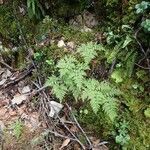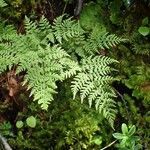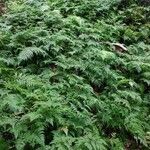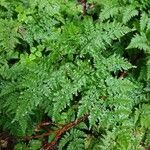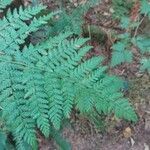Rhizomes long creeping, blackish brown, glabrate, with sparse brownish, ovate, membranous scales, more densely scaly at apex. Fronds distant; fertile fronds 20-49 cm; stipe blackish brown at lower part, upper part stramineous or pale chestnut-colored, (6-)14-31 cm, 1-3 × as long as lamina, with sparse brownish, ovate scales at base, upper part subglabrate with few scales; lamina 3-or 4-pinnate, rarely 4-pinnate-pinnatifid, subpentagonal, (5-)8-15(-20) cm long and wide, thinly herbaceous, apex acuminate; pinnae 4-7(-10) pairs, basal pinnae subopposite (upper pinnae alternate), spreading, shortly stalked (stalk 3-10 mm), ca. 2.5 cm apart from second basal pinnae, largest, deltoid-ovate or triangular, (2.5-)6-11(-13) × (2-)4-7 cm, base subtruncate, strongly inequilateral, 2-pinnate with pinnatipartite secondary pinnules, apex acuminate; pinnules (3-)6-8(-10) pairs, anadromous; acroscopic pinnules triangular, (0.4-) 1-2 × (6-)8-9(-12) mm, base subtruncate, equilateral, basiscopic pinnules prominently larger than acroscopic pinnules, nearly 2 × as long, apex acuminate; basal basiscopic pinnules of lowest pinnae largest, oblong-triangular, 2-3 × as long as acroscopic pinnules, 3-5 × 1.5-2.5 cm, inserted at costa at nearly right angles, sessile or with stalk 1-2 mm, base truncate, apex acuminate; secondary pinnules ca. 6 pairs, alternate, spreading, ovate to oblong, subacute, sessile, often decurrent to costules; acroscopic basal secondary pinnules shorter, deltoid-ovate, 4-9 × 3-6 mm, basiscopic pinnules up to 8-16 × 6-9 mm; secondary pinnule segments 4 or 5 pairs, subopposite, ascending, base cuneate, lobed to narrow wing of midrib, apex obtuse-rounded; ultimate segments oblique, lobed or slightly incised, rounded-obtuse. Veins pinnate, costules slightly tortuous, simple or forked, terminating in emarginations. Rachis, costae, and costules with unicellular hairs, multicellular hyaline hairs, or short glandular hairs. Sori small, brown, orbicular, abaxial on veins, 3-7 sori per ultimate segment; indusia pale green or yellow-brown, orbicular, thinly membranous. Perispore with short spinose or verrucose processes. 2n = 168.
More
Stems long-creeping, cordlike, internodes 1--2(--4) cm, old petiole bases few, hairs absent; scales usually tan to light brown, ovate-lanceolate, radial walls tan to brown, thin, luminae tan. Leaves monomorphic, at stem apex but not tightly clustered, to 45 cm, sori production about equal on all leaves (fairly independent of season). Petiole dark brown to black at base, gradually becoming green or straw-colored distally, (1--)2--3 times length of blades, sparsely scaly throughout. Blade elongate-pentagonal, 3(--4)-pinnate-pinnatifid; rachis and costae lacking gland-tipped hairs or bulblets; axils of pinnae with occasional multicellular gland-tipped hairs. Pinnae ascending, typically at acute angle to rachis, only proximal pinnae occasionally curving toward blade apex, margins serrate; proximal pinnae pinnate-pinnatifid, inequilateral, basal basiscopic pinnule stalked, enlarged, base truncate to obtuse; distal pinnae deltate to ovate. Veins directed into notches. Indusia cup-shaped, apex truncate, hairs gland-tipped only along margin. Spores spiny, usually 37--42 µm. 2 n = 168.
A small fern. The fronds are bright green and triangle shaped. They are 10-30 cm high.
